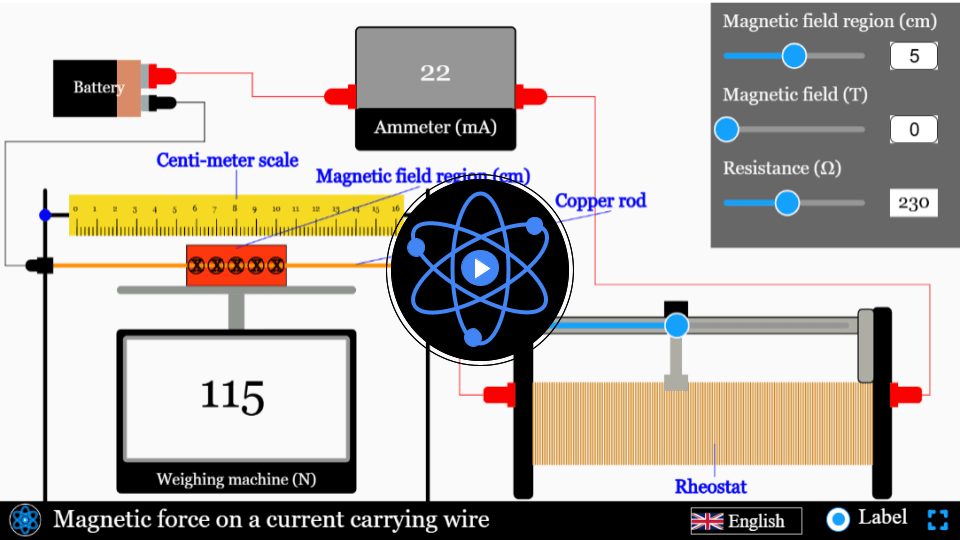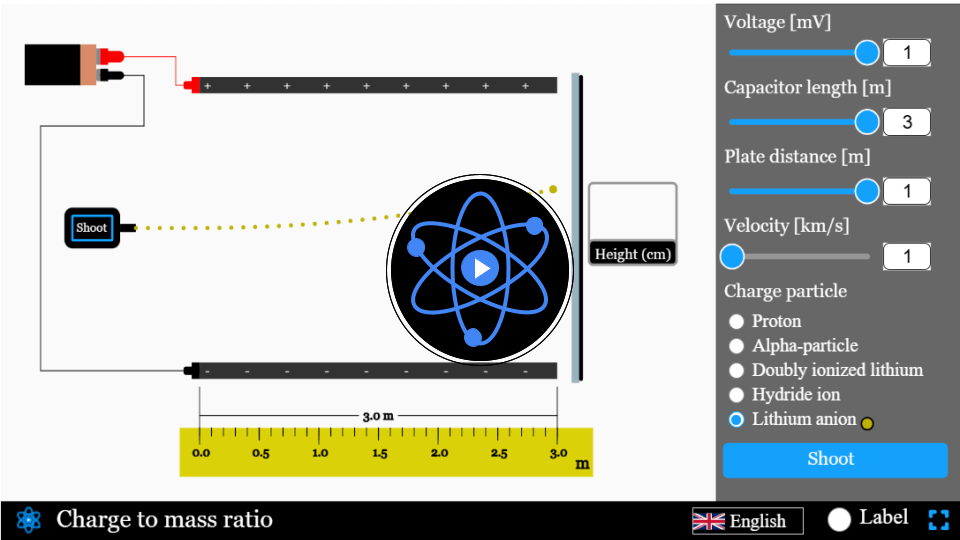Cyclotron simulator
Learn how a cyclotron works through our interactive simulator, where you can visualize and experiment with particle acceleration.
Cyclotron
Scientists around us are pushing the frontiers of physics to explore the fundamental nature of our world. Particle accelerators are the technological marvels that are helping our scientists unravel the mysteries of the subatomic world. Today, with the help of our simulators, we will delve into the working of one such particle accelerator- the cyclotron. Our simulator will help you visualize invisible forces, experiment with various controls, and observe how changing variables impact the trajectory & energy of charged particles. Perfect for researchers, students, and science enthusiasts alike—clarify your doubts, deepen your understanding, and start exploring the incredible world of particle physics today!
\(r=\frac{mv}{qB}\)
Mathematical description
where:
- \( r \) is the radius of particle trajectory
- \( m \) is the mass of particle
- \( v \) is the velocity of particle
- \( q \) is the charge of particle
- \( B \) is the magnetic field
Tutorial video
Take a quick spin through our simulator!
FAQs on Cyclotron
Qus 1. What is a cyclotron and how does it work?
A cyclotron is a type of particle accelerator that uses a combination of a magnetic field and a high-frequency electric field to accelerate charged particles in a spiral path. As the particles gain energy, they move in larger circles until they reach the desired speed and are extracted for use in various applications, such as medical treatments and scientific research.
Qus 2. What are the uses of a cyclotron?
Cyclotrons are used in multiple fields including medical imaging and therapy, where they produce radioisotopes for PET scans, and in physics research to study subatomic particles. They are also used in materials science for radiation damage studies and to generate high-energy beams for various industrial applications.
Qus 3. How is a cyclotron different from a linear accelerator?
A cyclotron accelerates particles in a circular path using magnetic and electric fields, while a linear accelerator (linac) propels particles in a straight line. Cyclotrons are more compact and efficient for certain applications, whereas linacs can achieve higher energies and are suitable for different types of research and medical treatments.
Qus 4. How does the magnetic field in a cyclotron affect particle acceleration?
The magnetic field in a cyclotron keeps charged particles moving in a circular path (Lorentz force), allowing them to be accelerated multiple times by the electric field as they spiral outward. This continuous acceleration process enables the cyclotron to achieve high particle energies efficiently.
Qus 5. Describe the trajectory of a charged particle inside a cyclotron?
In a cyclotron, a charged particle spirals outward instead of moving in a fixed circular path due to the acceleration process.
Magnetic Field: The magnetic field forces the particle into a circular path. The radius r of this path depends on the particle’s velocity, given by \(r=\frac{mv}{qB}\)
- Acceleration: The cyclotron has two hollow “D”-shaped electrodes called “dees.” An alternating electric field is applied between these dees, which accelerates the charged particle each time it crosses the gap between them. That’s why every time the particle crosses the gap, it gains kinetic energy and thus its velocity increases.
Spiraling Outward: As the particle’s velocity increases with each acceleration, the radius of its circular path also increases. Thus, the particle moves in an outward spiral.
Frequency Synchronization: The cyclotron’s alternating electric field frequency is synchronized with the particle’s motion, ensuring continuous acceleration and outward spiraling.
In summary, the particle spirals outward in a cyclotron because it gains velocity with each acceleration, increasing the radius of its path due to the magnetic field.
Qus 6. What are the advantages of using a cyclotron?
Cyclotrons offer several advantages, including compact size, cost-effectiveness, and the ability to produce a continuous stream of high-energy particles. These characteristics make them ideal for medical isotope production, cancer treatment, and various industrial applications.
Qus 7. How does a cyclotron produce radioisotopes for medical use?
Cyclotrons produce radioisotopes by bombarding target materials with high-energy particles. This process transforms the target atoms into radioactive isotopes, which are then used in diagnostic imaging and cancer therapy. The most common isotopes produced include Fluorine-18 for PET scans and Iodine-123 for thyroid imaging.
Qus 8. What are the limitations of a cyclotron?
Cyclotrons have limitations, such as the maximum energy they can impart to particles, which is constrained by their size and magnetic field strength. They are also less suitable for accelerating very heavy particles or achieving the extremely high energies needed for certain types of particle physics research.




